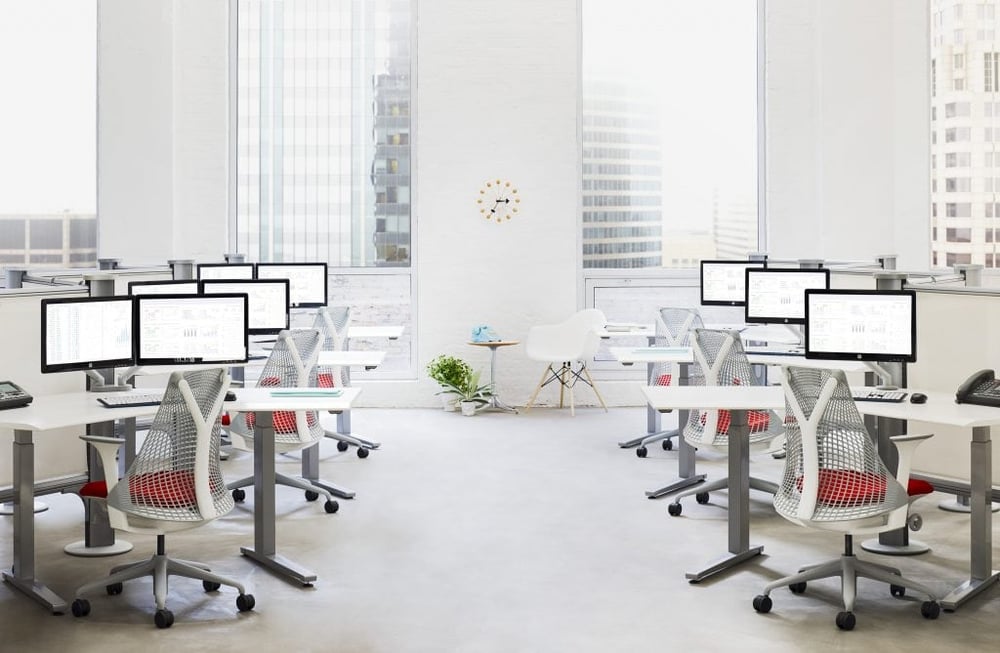Top interior designers balance collaboration and private workspaces to increase workplace productivity
Efforts to increase workplace productivity have changed ideas about office design dramatically in the last twenty years. In up to 70% of offices, open plan office designs have replaced the cubicles of yesteryear: desk areas are often shared and co-working lounges with off-beat furniture are supposed to foster collaboration and productivity. While open-plan office designs may reduce clutter and make conversation easier, they don’t guarantee an increase in workplace productivity.
Studies have shown that such office design “improvements” have reduced productivity. A leading furniture manufacturer reported 85% of employees are dissatisfied with the level of privacy in the workplace. Instead of collaborating, employees wear headphones all day and take work home to get things done. Depending on the unique needs of the company and the corporate culture, open office designs where everyone can see and hear each other can sometimes be extremely stressful and disruptive.
For maximum productivity, good office interior design must be balanced. Too much open space can increase distraction and make having privacy impossible. “Cubicle farm” designs can be isolating and discourage open communication. Pay attention to these interior design elements of a productive office space to encourage workplace productivity and engagement.
Plan an Office Design to Encourage Productivity
Design workplaces so employees can recharge between meetings and be able to focus without interruption. Cubicle panels and dividers that are tall enough for privacy support a productive office space. Use color throughout the office to help define quiet office areas or to energize collaborative spaces. In an open office environment, consider including an area that employees can use for private phone calls or a quiet space to focus on tasks.
Support Healthy Living for a Productive Office Space
Using natural light to illuminate an office space has many benefits. It’s eco-friendly, lifts moods and helps employees maintain natural circadian rhythms. Add natural daylight with skylights and try to give employees a window view. If possible, provide some outdoor green space for breaks. Use plants to bring some nature indoors and to help filter the air. A locker area for bicycles and other personal gear also supports healthy living and encourage an alternative way to commute.
To create a productive office space for employees, invest in desks and chairs with an ergonomic design – make sure the chair height, keyboard, and screen height can adjust for everyone. Encourage employees to change positions frequently during the day or even locations in the office. Many modern offices are incorporating standing desk areas or adjustable height desks to help alleviate health problems caused by prolonged sitting.
Semi-private lounge areas can provide a break from desk-sitting. Pod-style chairs that are enclosed on the sides or lounges that have high privacy backs have become popular in these spaces.
Flexible Office Design Promotes Workplace Productivity
Interior design that facilitates working together through ease of gathering encourages creativity and workplace productivity. Lounge style seating arranged in pods can complement a conference table or a large co-working desk. In private offices, a larger work surface and ergonomic guest chairs accommodate a small team.
Creating a perfectly balanced workplace interior design for productivity may take some experimentation. By acknowledging that people have different working styles and rhythms during the day, an office design can maximize workplace productivity and engage employees.
Is an Open Office Design Right for Your Workplace?
Benhar Office Interiors can help you reimagine your office floor plan and design. Contact us online or call us at 212-481-6666 for more information on how we can increase productivity through office design and furnishings.

(Image by Herman Miller)
Revolutionize Your Workspace Into a Hub of Inspiration
Our expert designers leverage a curated selection of premium furnishings and comprehensive design services, available through our trusted partnership with MillerKnoll and other top furniture brands, to bring the vision for your office to life. Our designs seamlessly blend functionality and style to create bespoke environments tailored to your team’s needs.
Let’s Talk